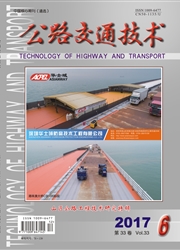

 中文摘要:
中文摘要:
为了解高原公路线形对驾驶员肌电特性影响,寻求提高行车安全途径以及今后道路线形设计参考依据。通过在新疆帕米尔高原G314路段进行驾驶员行车试验,利用生物反馈仪提取受测驾驶员肌电信号,利用频域分析方法选取平均功率频率(MPF)作为测评指标,定量分析其在海拔与道路线形影响下的变化规律,同时建立关系模型。分析结果表明:驾驶员颈部MPF会随着海拔的升高而减小;平曲线半径逐渐减小的路段上,驾驶员颈部MPF会减小,而纵坡度变化对MPF的影响并不显著;线形组合值增大会导致驾驶员颈部MPF减小;海拔与线形组合值共同影响下,驾驶员颈部MPF变化明显,海拔越高、线形组合值越大,驾驶员颈部MPF越小。
 英文摘要:
英文摘要:
In order to know the influence of plateau highway line-type on driver EMG characteristic and seek to the way of improving the traffic safety as well as the reference of roads alignment in the future. A driving experiments were carried out in plateau roads of Xinjiang Pamirs and the biofeedback instrument was used to test drivers' electromyography signal, at the same time, MPF was chosen by the frequency domain analysis as evaluation index for getting the change rule and model of MPF between altitude and road alignment. The analysis show that the drivers' MPF will go down with the increase altitude, that the more smaller radius of a horizontal road curve, the more decrease drivers' MPF, but longitudinal slope has no significant effect on the MPF, that an increase in alignment combination will lead to a decrease of drivers' MPF, and that drivers' MPF will decrease more significantly when the increase of both the altitude and alignment combination.
 同期刊论文项目
同期刊论文项目
 同项目期刊论文
同项目期刊论文
 期刊信息
期刊信息
